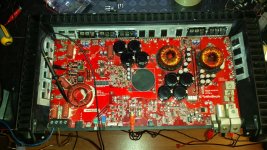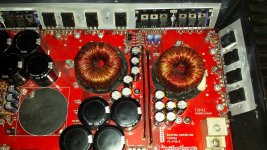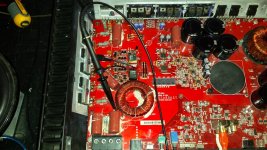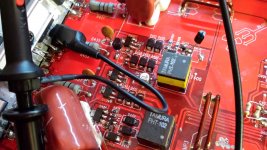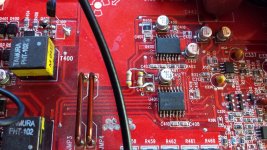This amplifier was delivered with burned power supply MOSFET and 4 MOSFET outputs in short. I've fixed the power supply perfectly but I can not understand why I have this kind of audio problem. I had to replace all output MOSFETs, rebuilding the driver stage (also q407 and q401 originally 2n5087, but I used 2n5086). I have a good carrying signal and the same is true for toggle A and Toggle B signals, I have normal signals also on both uc3706dws. The amplifier lights up well and low volume produces clean audio, but as soon as the volume is raised, the signal becomes incomprehensible. For security I replaced the gain potentiometer, but it has not changed anything .... Ideas?
this is a video with the issue!
Rockford fosgate t20001bd repairing - YouTube
this is a video with the issue!
Rockford fosgate t20001bd repairing - YouTube
Attachments
Last edited:
yes Sir, the signal to u300 pin7 remain clean.Does audio remain clean at U300, pin 7?
But I noticed another strange thing.
I connected my oscilloscope directly to the output terminals (after the inductor).
Without connecting a loudspeaker, the signal is clean; As soon as I connect a small speaker, the signal is destroyed in the negative half wave (see the second video I've attached to this post).
Uc3706dw defective?
T400 or t401 faulty?
Or MMBA812M6 (Q407 and Q401) instead of MMBT5087L can not replace?
I do not have great experience with this type of amplifier, but it seems to me a driver driver problem, or am I wrong?
https://www.youtube.com/watch?v=LbBek8SdF-c
Last edited:
It's difficult to see the drive signals for the audio section when operating normally unless you have a battery powered scope. To see it clearly, I remove the rectifiers. Then you can ground the scope to the source leg of any of the audio FETs with no risk.
A couple of other notes...
Some class D amps don't work well when the insulator type is changed. I don't know if this applies to this particular amp.
I've never tried that transistor sub so I don't know if it's a factor.
A couple of other notes...
Some class D amps don't work well when the insulator type is changed. I don't know if this applies to this particular amp.
I've never tried that transistor sub so I don't know if it's a factor.
Do you refer to the video in post n # 1?It's difficult to see the drive signals for the audio section when operating normally unless you have a battery powered scope. To see it clearly, I remove the rectifiers. Then you can ground the scope to the source leg of any of the audio FETs with no risk.
A couple of other notes...
Some class D amps don't work well when the insulator type is changed. I don't know if this applies to this particular amp.
I've never tried that transistor sub so I don't know if it's a factor.
In that video, I showed the rail to rail oscillation before the inductor, it was not the signal on the mosfet gate.
In the second video (in post n # 2) I showed the signal at the output of the amplifier, after the inductor.
At input I have a 50 Hz signal; At the output I have an identical (but amplified) signal only if there are no connected speakers.
When I connect a speaker, the output signal changes to such a degree as to be noisy (as shown on the oscilloscope).
I could see the signal on the mosfet gate, when I had not yet mounted the new mosfets; The signals at that time were just as I was expecting them.
I would like to cover this topic.
The last time I burned the output devices, so I decided to abandon the repair, but now I got new devices, so I decided to try again.
I checked the driver stage (pzta56-pzta06-mmbt5087l + various resistors) and + everything in the normal (without the output devices, gate signals are clean and perfect with a strong input signal of 100hz)
After installing the output devices (IRFP260) I can see rail to rail oscillation before the inductor, but the audio signal at the output is kept clean only with low volume, as soon as it increases, the signal becomes distorted in an incredible way and end the amplifier goes into protection, then it works again, then again protection and so on.
When that happens, I have tested all the test points (in accordance with the schematic) and everything is in the norm.
Bad feedback network?
DO NOT EVEN WHAT TO CONTROL.
The last time I burned the output devices, so I decided to abandon the repair, but now I got new devices, so I decided to try again.
I checked the driver stage (pzta56-pzta06-mmbt5087l + various resistors) and + everything in the normal (without the output devices, gate signals are clean and perfect with a strong input signal of 100hz)
After installing the output devices (IRFP260) I can see rail to rail oscillation before the inductor, but the audio signal at the output is kept clean only with low volume, as soon as it increases, the signal becomes distorted in an incredible way and end the amplifier goes into protection, then it works again, then again protection and so on.
When that happens, I have tested all the test points (in accordance with the schematic) and everything is in the norm.
Bad feedback network?
DO NOT EVEN WHAT TO CONTROL.
- Status
- This old topic is closed. If you want to reopen this topic, contact a moderator using the "Report Post" button.
- Home
- General Interest
- Car Audio
- RF t20001bd Unresolved problem
